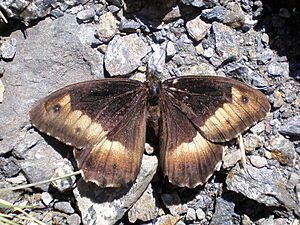Woodland grayling facts for kids
Quick facts for kids Woodland grayling |
|
|---|---|
 |
|
| in Andorra | |
 |
|
| male, Republic of North Macedonia | |
| Conservation status | |
| Scientific classification | |
| Synonyms | |
|
The woodland grayling (Hipparchia fagi) is a beautiful butterfly that belongs to the Nymphalidae family. These large, dark brown butterflies are often seen flying in woodlands across Europe.
Contents
What's in a Name?
The scientific name fagi comes from the Latin word for "beech tree." This is because these butterflies often live in forests where beech trees grow.
Different Kinds of Woodland Graylings
Sometimes, animals have slightly different groups called subspecies. For the woodland grayling, there's one known subspecies:
- Hipparchia fagi tetrica
Where They Live
The woodland grayling butterfly lives in many parts of Europe. You can find them mainly south of the Alps mountains. They live in countries like France, Germany, Italy, Spain, and Greece.
These butterflies like to live in different kinds of forests. They can be found in places with broad-leaved trees or pine trees. You might also see them in grassy areas or along forest paths. They live from sea level up to about 1,600 meters high.
What They Look Like
Woodland graylings are large butterflies. Their wingspan is usually between 66 and 76 millimeters. That's about the length of a credit card!
Wing Colors and Patterns
The top side of their wings is dark brown. They have a white band near the edge, which is easier to see on female butterflies. Each front wing has one black eyelet at the tip.
Male butterflies have a very small eyelet on each back wing. Sometimes, this eyelet has a white dot in the middle. Females usually have one or two larger eyelets.
The underside of their front wings looks similar to the top. The underside of their back wings is a mix of brown and white, with a wide white band. This white band on the back wings is curved.
Amazing Camouflage
The colors and patterns on these butterflies help them hide. They are excellent camouflage when the butterfly rests on tree bark. When their wings are closed, their eye spots are hidden.
The woodland grayling looks a lot like another butterfly called Hipparchia hermione, but it is larger. It also looks similar to Hipparchia syriaca and Hipparchia genava.
Caterpillar Appearance
The caterpillar of the woodland grayling has a pale brown head. It has four darker stripes on its head. Its body is light brown with a split end at the back. It also has a dark brown stripe down its back and brownish stripes along its sides.
Life Cycle
Adult woodland grayling butterflies fly from June to September. They have one generation each year. This means the caterpillars hatch, grow, and turn into butterflies all within one year.
The caterpillars spend the winter months resting. They eat different types of grass to grow. Some of their favorite grasses include Brachypodium pinnatum, Bromus erectus, and Festuca rubra.


